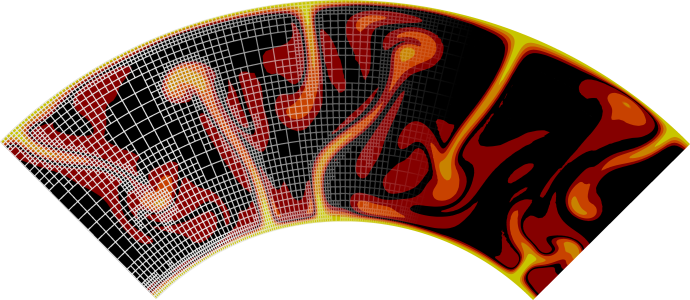Arbitrary Lagrangian-Eulerian implementation#
The question of how to handle the motion of the mesh with a free surface is challenging. Eulerian meshes are well behaved, but they do not move with the fluid motions, which makes them difficult for use with free surfaces. Lagrangian meshes do move with the fluid, but they quickly become so distorted that remeshing is required. ASPECT implements an Arbitrary Lagrangian-Eulerian (ALE) framework for handling motion of the mesh. The ALE approach tries to retain the benefits of both the Lagrangian and the Eulerian approaches by allowing the mesh motion \(\textbf{u}_m\) to be largely independent of the fluid. The mass conservation condition requires that \(\textbf{u}_m \cdot \textbf{n} = \textbf{u} \cdot \textbf{n}\) on the free surface, but otherwise the mesh motion is unconstrained, and should be chosen to keep the mesh as well behaved as possible.
ASPECT uses a Laplacian scheme for calculating the mesh velocity. The mesh velocity is calculated by solving
Here, \(\partial \Omega_{\textrm{deformation}}\) are all boundaries with active mesh deformation processes (specified in Parameter name: Mesh deformation boundary indicators), \(\partial \Omega_{\textrm{tangential}}\) are all boundaries along which tangential mesh deformation is allowed (all boundaries in Parameter name: Tangential velocity boundary indicators and Parameter name: Additional tangential mesh velocity boundary indicators), and \(\partial \Omega_{\textrm{remaining}}\) are all remaining boundaries where no mesh deformation is allowed.
\(\textbf{u}_{m,i}\) are the individual mesh deformation processes that deform the boundary of the mesh on \(\partial \Omega_{\textrm{deformation}}\), whose individual contributions are added to compute the final mesh deformation along these boundaries. Examples for such deformation processes are a free surface (\(\textbf{u}_{m,i} = \left( \textbf{u} \cdot \textbf{n} \right) \textbf{n}\)), an analytically prescribed mesh velocity (\(\textbf{u}_{m,i} = \textbf{f}(\textbf{x},t)\)), or more complicated expressions like the solution of a diffusion equation for topography or a landscape evolution model.
After this mesh velocity is calculated, the mesh vertices are time-stepped explicitly. This scheme has the effect of choosing a minimally distorting perturbation to the mesh. Because the mesh velocity is no longer zero in the ALE approach, we must then correct all velocities that act on quantities defined relative to the mesh position with the mesh velocity, e.g. the Eulerian advection terms in the advection system (see, e.g., [Donea et al., 2004]). For instance, the temperature equation (26) becomes
This correction ensures that material only enters or leaves the domain through a deforming boundary if the flow velocity \(\mathbf{u}\) is not equal to the mesh velocity \(\mathbf{u}_m\) at the boundary. Please note that this also means prescribed velocity boundary conditions are defined in a stationary coordinate system, not a coordinate system that moves with the mesh. For example an inflow velocity of 5 cm/yr at a boundary that moves with 7 cm/yr into the model domain actually leads to an outflow of material with a relative velocity of 2 cm/yr.

